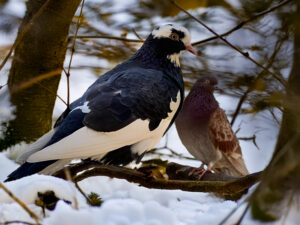
The Fascinating World of Tumbler Pigeons: A Dive into Feathered Acrobatics
When you think of pigeons, your mind might jump to the bustling streets of a city square, birds pecking around for crumbs. But among the vast family of pigeons exists a spectacular group known as tumbler pigeons—birds that have turned flight into an art form.
What Are Tumbler Pigeons?
Tumbler pigeons are a collection of domesticated pigeon breeds that have been selectively bred over centuries for one dazzling reason: their ability to perform flips and somersaults while flying. Unlike their streetwise cousins, tumblers aren’t just flying from point A to point B—they’re putting on a show.
The name “tumbler” comes from this distinctive behavior: mid-flight, they execute rapid, controlled backward flips, sometimes singly, sometimes in a breathtaking series. Watching a good tumbler perform is like watching a living acrobat against the sky.
A Little History
Tumbler pigeons boast a history as rich and mysterious as the birds themselves. Records of tumbling pigeons date back hundreds of years, particularly in Persia (modern-day Iran), India, and the Middle East. They were prized for their beauty and aerial skills, and breeding them was both a pastime and a point of prestige.
As trade routes expanded and pigeon fancying became popular across Europe, tumbler breeds spread and diversified. Today, you’ll find many recognized tumbler breeds across the world, each with its own quirks and style.
Popular Tumbler Breeds
-
Birmingham Roller: Perhaps the most famous, these birds don’t just tumble—they roll repeatedly through the air, often in mesmerizing, coordinated group performances called “kits.”
-
Iranian Highflyer: Known for incredible altitude and endurance, these birds can fly for hours, mixing soaring with impressive tumbling.
-
Parlor Tumbler: A ground-bound cousin, these birds perform backward flips on land and are actually unable to fly. They “roll” across the floor in playful bursts.
Each breed has been shaped by years of careful selection, aiming for precision, style, and heart.
Why Do They Tumble?
The exact science behind tumbling isn’t completely understood, but it seems to be a combination of genetics and training. Some suggest it’s a neurological trait—a kind of controlled seizure—but in a way that’s beneficial and non-harmful to the bird. Whatever the root cause, tumbling behavior is instinctual in well-bred birds, though fanciers often train young pigeons to perfect their technique.
Raising and Keeping Tumblers
Caring for tumbler pigeons requires dedication. Good nutrition, clean lofts, regular training, and lots of patience are key. Fanciers often spend years developing a “kit” of rollers that can fly and tumble in synchronized beauty.
For many, the joy comes not just from watching the performances but also from the bond they form with their birds—knowing the quirks of each pigeon, encouraging them, and watching them grow into confident little aerialists.
More Than Just Tricks
At their core, tumbler pigeons remind us of the incredible diversity and wonder that can arise from the bond between humans and animals. Through careful stewardship and a shared love of flight, we’ve nurtured a living art form that connects the skies of today with the traditions of centuries past.
So next time you glance up at a flock of birds overhead, take a closer look—you might just spot a tumbler turning the sky into its own private stage.
